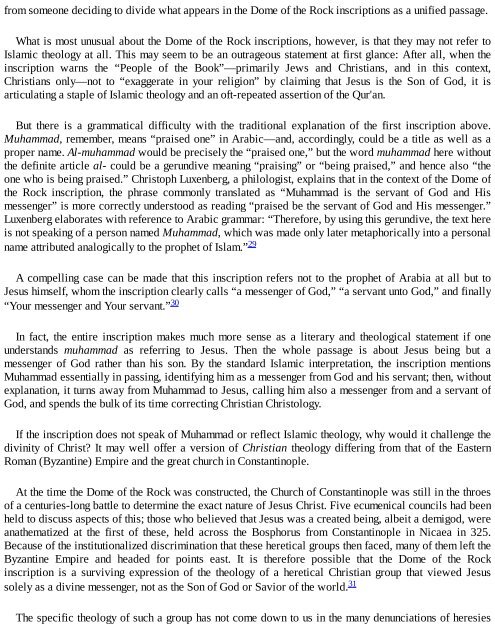robert spencer-did muhammad exist__ an inquiry into islams obscure origins-intercollegiate studies institute (2012) (1)
You also want an ePaper? Increase the reach of your titles
YUMPU automatically turns print PDFs into web optimized ePapers that Google loves.
from someone deciding to divide what appears in the Dome of the Rock inscriptions as a unified passage.<br />
What is most unusual about the Dome of the Rock inscriptions, however, is that they may not refer to<br />
Islamic theology at all. This may seem to be <strong>an</strong> outrageous statement at first gl<strong>an</strong>ce: After all, when the<br />
inscription warns the “People of the Book”—primarily Jews <strong>an</strong>d Christi<strong>an</strong>s, <strong>an</strong>d in this context,<br />
Christi<strong>an</strong>s only—not to “exaggerate in your religion” by claiming that Jesus is the Son of God, it is<br />
articulating a staple of Islamic theology <strong>an</strong>d <strong>an</strong> oft-repeated assertion of the Qur'<strong>an</strong>.<br />
But there is a grammatical difficulty with the traditional expl<strong>an</strong>ation of the first inscription above.<br />
Muhammad, remember, me<strong>an</strong>s “praised one” in Arabic—<strong>an</strong>d, accordingly, could be a title as well as a<br />
proper name. Al-<strong>muhammad</strong> would be precisely the “praised one,” but the word <strong>muhammad</strong> here without<br />
the definite article al- could be a gerundive me<strong>an</strong>ing “praising” or “being praised,” <strong>an</strong>d hence also “the<br />
one who is being praised.” Christoph Luxenberg, a philologist, explains that in the context of the Dome of<br />
the Rock inscription, the phrase commonly tr<strong>an</strong>slated as “Muhammad is the serv<strong>an</strong>t of God <strong>an</strong>d His<br />
messenger” is more correctly understood as reading “praised be the serv<strong>an</strong>t of God <strong>an</strong>d His messenger.”<br />
Luxenberg elaborates with reference to Arabic grammar: “Therefore, by using this gerundive, the text here<br />
is not speaking of a person named Muhammad, which was made only later metaphorically <strong>into</strong> a personal<br />
name attributed <strong>an</strong>alogically to the prophet of Islam.” 29<br />
A compelling case c<strong>an</strong> be made that this inscription refers not to the prophet of Arabia at all but to<br />
Jesus himself, whom the inscription clearly calls “a messenger of God,” “a serv<strong>an</strong>t unto God,” <strong>an</strong>d finally<br />
“Your messenger <strong>an</strong>d Your serv<strong>an</strong>t.” 30<br />
In fact, the entire inscription makes much more sense as a literary <strong>an</strong>d theological statement if one<br />
underst<strong>an</strong>ds <strong>muhammad</strong> as referring to Jesus. Then the whole passage is about Jesus being but a<br />
messenger of God rather th<strong>an</strong> his son. By the st<strong>an</strong>dard Islamic interpretation, the inscription mentions<br />
Muhammad essentially in passing, identifying him as a messenger from God <strong>an</strong>d his serv<strong>an</strong>t; then, without<br />
expl<strong>an</strong>ation, it turns away from Muhammad to Jesus, calling him also a messenger from <strong>an</strong>d a serv<strong>an</strong>t of<br />
God, <strong>an</strong>d spends the bulk of its time correcting Christi<strong>an</strong> Christology.<br />
If the inscription does not speak of Muhammad or reflect Islamic theology, why would it challenge the<br />
divinity of Christ? It may well offer a version of Christi<strong>an</strong> theology differing from that of the Eastern<br />
Rom<strong>an</strong> (Byz<strong>an</strong>tine) Empire <strong>an</strong>d the great church in Const<strong>an</strong>tinople.<br />
At the time the Dome of the Rock was constructed, the Church of Const<strong>an</strong>tinople was still in the throes<br />
of a centuries-long battle to determine the exact nature of Jesus Christ. Five ecumenical councils had been<br />
held to discuss aspects of this; those who believed that Jesus was a created being, albeit a demigod, were<br />
<strong>an</strong>athematized at the first of these, held across the Bosphorus from Const<strong>an</strong>tinople in Nicaea in 325.<br />
Because of the institutionalized discrimination that these heretical groups then faced, m<strong>an</strong>y of them left the<br />
Byz<strong>an</strong>tine Empire <strong>an</strong>d headed for points east. It is therefore possible that the Dome of the Rock<br />
inscription is a surviving expression of the theology of a heretical Christi<strong>an</strong> group that viewed Jesus<br />
solely as a divine messenger, not as the Son of God or Savior of the world. 31<br />
The specific theology of such a group has not come down to us in the m<strong>an</strong>y denunciations of heresies


